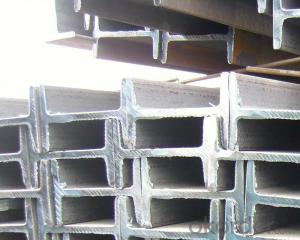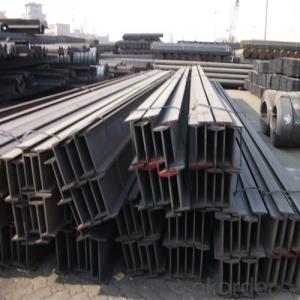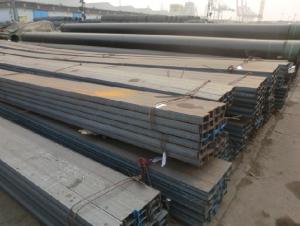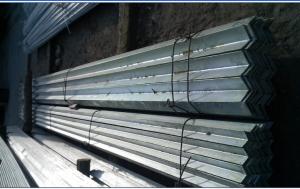Steel I-Beam
- Loading Port:
- Tianjin Port, China
- Payment Terms:
- TT or L/C
- Min Order Qty:
- 25MT m.t.
- Supply Capability:
- 500MT Per Day m.t./month
OKorder Service Pledge
OKorder Financial Service
You Might Also Like
Specifications of Steel I-Beam
Production Standard: GB Standard, EN10025, DIN, JIS, etc.
Material of Steel I-Beam: Q235,SS400,A36,ST37-2,S235JR
Length: 5.8M, 6M, 9M, 12M or as the requriements of the clients
Sizes: 80MM-270MM
Section | Standard Sectional Dimensions(mm) | ||||
| h | b | s | t | Mass Kg/m |
IPE80 | 80 | 46 | 3.80 | 5.20 | 6.00 |
IPE100 | 100 | 55 | 4.10 | 5.70 | 8.10 |
IPE120 | 120 | 64 | 4.80 | 6.30 | 10.40 |
IPE140 | 140 | 73 | 4.70 | 6.90 | 12.90 |
IPE160 | 160 | 82 | 5.00 | 7.40 | 15.80 |
IPE180 | 180 | 91 | 5.30 | 8.00 | 18.80 |
IPE200 | 200 | 100 | 5.60 | 8.50 | 22.40 |
IPE220 | 220 | 110 | 5.90 | 9.20 | 26.20 |
IPE240 | 240 | 120 | 6.20 | 9.80 | 30.70 |
IPE270 | 270 | 135 | 6.60 | 10.20 | 36.10 |
IPEAA80 | 80 | 46 | 3.20 | 4.20 | 4.95 |
IPEAA100 | 100 | 55 | 3.60 | 4.50 | 6.72 |
IPEAA120 | 120 | 64 | 3.80 | 4.80 | 8.36 |
IPEAA140 | 140 | 73 | 3.80 | 5.20 | 10.05 |
IPEAA160 | 160 | 82 | 4.00 | 5.60 | 12.31 |
IPEAA180 | 180 | 91 | 4.30 | 6.50 | 15.40 |
IPEAA200 | 200 | 100 | 4.50 | 6.70 | 17.95 |
Usages of Steel I-Beam
According to the needs of different structures, steel I-beam can compose to different force support component, and also can be the connections between components. They are widely used in various building structures and engineering structures such as roof beams, bridges, transmission towers, hoisting machinery and transport machinery, ships, industrial furnaces, reaction tower, container frame and warehouse etc.
Packaging & Delivery of Steel I-Beam
1. Packing: it is nude packed in bundles by steel wire rod
2. Bundle weight: not more than 3.5MT for bulk vessel; less than 3 MT for container load
3. Marks:
Color marking: There will be color marking on both end of the bundle for the cargo delivered by bulk vessel. That makes it easily to distinguish at the destination port.
Tag mark: there will be tag mark tied up on the bundles. The information usually including supplier logo and name, product name, made in China, shipping marks and other information request by the customer.
If loading by container the marking is not needed, but we will prepare it as customer request.
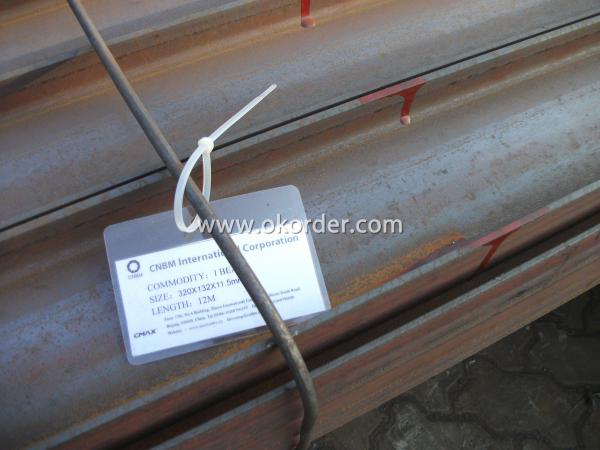
4. Transportation: the goods are delivered by truck from mill to loading port, the maximum quantity can be loaded is around 40MTs by each truck. If the order quantity cannot reach the full truck loaded, the transportation cost per ton will be little higher than full load.
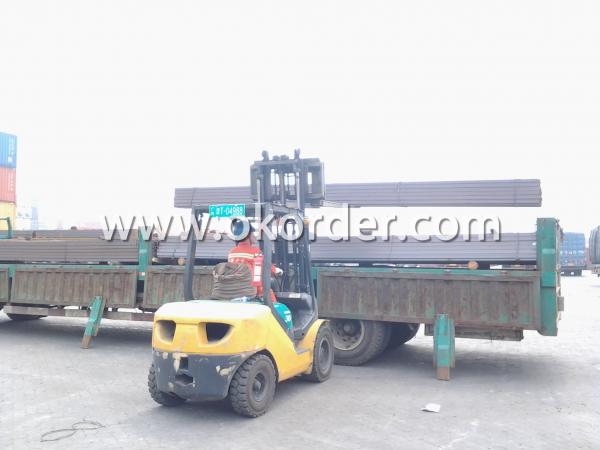
5. Delivered by container or bulk vessel


6. Delivery time: All the structural steel I beams will be at the port of the shipment within 45 days after receiving the L/C at sight ot the advance pyment.
7. Payment: L/C at sight; 30% advance payment before production, 70% before shipment by T/T, etc.
Production flow of Steel I-Beam
Material prepare (billet) —heat up—rough rolling—precision rolling—cooling—packing—storage and transportation
- Q:What are the different types of steel I-beam connections for beam-to-beam joints?
- There are several different types of steel I-beam connections for beam-to-beam joints, including bolted connections, welded connections, and moment connections. Bolted connections involve using bolts and nuts to secure the beams together, while welded connections involve welding the beams together. Moment connections are designed to provide rotational flexibility to the joint, allowing for greater load-bearing capacity.
- Q:What are the common methods of protecting steel I-beams from seismic forces?
- There exists a variety of methods for safeguarding steel I-beams against seismic forces. One prevalent approach involves the utilization of specialized seismic bracing systems. These systems encompass additional steel components or braces that are specifically engineered to absorb and dissipate the energy generated during an earthquake. Strategically placed, these braces provide lateral support to the I-beams, averting buckling or collapse under seismic forces. Another technique involves reinforcing the I-beams by affixing steel plates or angles to their flanges. These supplementary elements augment the overall strength and rigidity of the beams, rendering them more resistant to seismic forces. Often, this method is employed in conjunction with other reinforcement techniques to establish an all-encompassing protective system. In certain instances, engineers may also opt to install dampers or shock absorbers at the connections between the I-beams and other structural elements. These devices contribute to the dissipation of the energy produced during an earthquake, thereby reducing the impact on the I-beams and minimizing the potential for damage. Furthermore, the proper design and detailing of the steel I-beams play a pivotal role in safeguarding them against seismic forces. Engineers must take into account factors such as anticipated ground movement, the structure's weight and configuration, and the specific requirements of the building code to ensure the I-beams receive adequate protection. In summary, a combination of seismic bracing systems, reinforcement techniques, and meticulous design considerations are commonly employed to safeguard steel I-beams against seismic forces. These methods serve to uphold the structural integrity of the beams and mitigate the risk of damage during an earthquake.
- Q:What are the different accessories or attachments used with steel I-beams?
- Steel I-beams commonly utilize various accessories and attachments to improve their functionality and structural integrity. Some of these accessories include: 1. Beam clamps, which securely fasten the steel I-beams to other structural elements or support systems. They come in different sizes and designs to accommodate diverse beam sizes and load requirements. 2. Beam connectors, which join multiple steel I-beams together to form a continuous beam. They are particularly useful in long-span applications or when additional strength is necessary. 3. Beam hangers, which suspend the steel I-beams from overhead structures or support systems. They offer a reliable and secure means of supporting the beams, especially in situations with limited space for support columns. 4. Lateral braces, which provide added stability and prevent lateral movement of the steel I-beams. These braces are typically installed at regular intervals along the beam's length and can be either welded or bolted to the beam. 5. End plates, which connect the ends of steel I-beams to other structural elements or support systems. These plates are typically bolted or welded to the beam ends, offering a secure connection capable of withstanding high loads and forces. 6. Cleats, small steel plates that are welded or bolted to the sides of the steel I-beams. Cleats provide additional support and prevent beam twisting or rotation under load. 7. Brackets, which support other components or fixtures attached to the steel I-beams. Brackets can be welded or bolted to the beams and are commonly employed to support equipment, lighting fixtures, or other building systems. These accessories and attachments play a critical role in ensuring the proper installation, support, and functionality of steel I-beams across various construction and structural applications.
- Q:Can steel I-beams be used in coastal areas?
- Yes, steel I-beams can be used in coastal areas. However, it is important to select the appropriate grade of steel and apply proper corrosion protection measures to ensure the longevity and durability of the beams against the corrosive effects of saltwater and coastal conditions.
- Q:How do steel I-beams perform in high-temperature bridge applications?
- Due to their inherent high strength and excellent fire resistance properties, steel I-beams perform effectively in high-temperature bridge applications. The design of I-beams enables them to endure significant loads and provide stability even in extreme conditions, such as high temperatures. The ability of steel I-beams to maintain their structural integrity at elevated temperatures is one of the primary reasons they are suitable for high-temperature bridge applications. Unlike materials like wood or concrete, steel does not significantly degrade or lose its strength under intense heat. This characteristic is crucial in bridge construction as it guarantees the safety and dependability of the structure, even in extreme circumstances. Furthermore, steel I-beams have a high melting point, making them resistant to deformations caused by heat. This quality allows the bridge to preserve its shape and structural stability when exposed to intense heat. Additionally, steel's low thermal expansion coefficient minimizes the risk of structural distortion resulting from temperature fluctuations. In the event of a fire, steel I-beams also provide exceptional fire resistance. Steel is non-combustible and does not contribute to the spread of fire, giving it an advantage over other materials. Additionally, steel's high thermal conductivity aids in the rapid dissipation of heat, preventing localized overheating and reducing the risk of structural failure. To enhance the performance of steel I-beams in high-temperature bridge applications, various measures can be implemented. For example, the steel can be coated with fire-resistant materials, such as intumescent paint or fireproof insulation, to add an extra layer of protection against high temperatures. Additionally, fire-resistant barriers can be included in the bridge design to confine potential fires and minimize their impact on the structure. In conclusion, steel I-beams are highly appropriate for high-temperature bridge applications due to their exceptional strength, fire resistance, and ability to withstand extreme conditions. Their structural integrity, resistance to heat-related deformations, and superb fire resistance make them a dependable choice for constructing bridges that can endure high temperatures and ensure the safety of the infrastructure and its users.
- Q:What are the common types of connections for steel I-beams in moment-resisting frames?
- The common types of connections for steel I-beams in moment-resisting frames are fully restrained connections, partially restrained connections, and simple connections.
- Q:What are the common defects or issues found in steel I-beams?
- Some common defects or issues found in steel I-beams include: 1. Corrosion: Steel I-beams are susceptible to corrosion, especially in environments with high humidity or exposure to chemicals. Corrosion weakens the structural integrity of the beam, leading to reduced load-bearing capacity and potential failure. 2. Welding defects: Welding is commonly used to join different sections of I-beams. However, improper welding techniques or insufficient quality control can lead to defects such as cracks, porosity, or incomplete penetration. These defects can compromise the strength and durability of the beam. 3. Buckling: Steel I-beams are designed to resist compressive forces, but excessive loads or inadequate design can cause buckling. Buckling occurs when the beam bends or deforms under compression, resulting in a loss of stability and load-bearing capacity. 4. Fatigue cracking: Repeated or cyclic loading can cause fatigue cracks to develop in steel I-beams. These cracks often originate from stress concentrations or other defects and can gradually propagate, leading to catastrophic failure if not detected and repaired. 5. Manufacturing defects: Steel I-beams can sometimes have manufacturing defects, such as improper rolling or casting. These defects can result in uneven or weak sections along the beam, compromising its structural integrity. 6. Misalignment: During installation or due to structural shifts, steel I-beams can become misaligned. Misalignment can lead to uneven distribution of loads, excessive stress concentrations, and potential failure. 7. Insufficient fire resistance: Steel I-beams have poor fire resistance compared to other building materials. During a fire, the high temperatures can weaken the steel and cause structural failure, endangering the overall stability of the building. It is essential to inspect and maintain steel I-beams regularly to identify and address these defects or issues promptly. Regular inspections, proper design, quality control during manufacturing, and appropriate protective coatings can help minimize the occurrence of these problems and ensure the safety and longevity of steel structures.
- Q:Can steel I-beams be used for overhead garage doors?
- No, steel I-beams cannot be used for overhead garage doors. Steel I-beams are typically used for structural support in buildings and are not designed to support the weight and movement of a garage door. Overhead garage doors require specialized tracks and springs to properly function, and using steel I-beams in place of these components would compromise the safety and functionality of the door. It is essential to follow the manufacturer's specifications and guidelines when installing or repairing garage doors to ensure proper operation.
- Q:Can steel I-beams be used for high-temperature applications?
- Yes, steel I-beams can be used for high-temperature applications. Steel is known for its strength and durability, which allows it to withstand high temperatures without significant deformation or structural failure. However, the specific temperature limit for steel I-beams depends on the grade of steel used and the duration of exposure to high temperatures. It is important to consider the material properties and potential effects of thermal expansion when using steel I-beams in high-temperature environments.
- Q:Can steel I-beams be used in water or wastewater treatment plant construction?
- Yes, steel I-beams can be used in water or wastewater treatment plant construction. Steel I-beams are commonly used in construction due to their strength, durability, and versatility. They are able to support heavy loads and provide structural integrity, making them suitable for various applications in water and wastewater treatment plants. In water treatment plants, steel I-beams can be used to support and reinforce the structures that house the treatment processes. They can be used in the construction of sedimentation tanks, clarifiers, filtration systems, and chemical treatment facilities. Steel I-beams provide a sturdy framework that can withstand the weight of equipment, machinery, and water storage tanks used in the treatment process. Similarly, in wastewater treatment plants, steel I-beams can be utilized for various purposes. They can be used in the construction of aeration tanks, digesters, sludge dewatering facilities, and pumping stations. Steel I-beams can support the weight of large tanks and equipment, ensuring the stability and safety of the structures. Additionally, steel I-beams are resistant to corrosion, making them well-suited for water and wastewater treatment plant environments. The presence of chemicals, moisture, and varying temperatures in these facilities can cause deterioration in some construction materials. However, steel I-beams are durable and can withstand these harsh conditions, making them a reliable choice for long-term use in water and wastewater treatment plant construction. Overall, steel I-beams are commonly used in water and wastewater treatment plant construction due to their strength, durability, versatility, and resistance to corrosion. They provide the necessary support and structural integrity required for these facilities, ensuring the efficient and safe operation of the treatment processes.
1. Manufacturer Overview |
|
|---|---|
| Location | Qinhuangdao, China |
| Year Established | 2000 |
| Annual Output Value | Above US$ 300 Million |
| Main Markets | Mid East; Africa; Southeast Asia; Brazil |
| Company Certifications | ISO 9001:2008; |
2. Manufacturer Certificates |
|
|---|---|
| a) Certification Name | |
| Range | |
| Reference | |
| Validity Period | |
3. Manufacturer Capability |
|
|---|---|
| a)Trade Capacity | |
| Nearest Port | Tianjin; |
| Export Percentage | 70% - 80% |
| No.of Employees in Trade Department | 21-50 People |
| Language Spoken: | English; Chinese; |
| b)Factory Information | |
| Factory Size: | Above 400,000 square meters |
| No. of Production Lines | 2 |
| Contract Manufacturing | OEM Service Offered; |
| Product Price Range | Average |
Send your message to us
Steel I-Beam
- Loading Port:
- Tianjin Port, China
- Payment Terms:
- TT or L/C
- Min Order Qty:
- 25MT m.t.
- Supply Capability:
- 500MT Per Day m.t./month
OKorder Service Pledge
OKorder Financial Service
Similar products
New products
Hot products
Hot Searches
Related keywords













